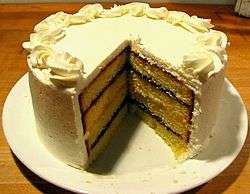Tiramisu
|
Tiramisu with Blueberries and Raspberries | |
| Course | Dessert |
|---|---|
| Place of origin | Treviso, Veneto |
| Creator | Robert Linguanotto |
| Serving temperature | cold |
| Main ingredients | Savoiardi, egg yolks, mascarpone, cocoa, coffee |
|
| |
Tiramisu (from Italian, spelled tiramisù [tiramiˈsu], meaning "pick me up", "cheer me up" or "lift me up") is a popular coffee-flavoured Italian custard dessert. It is made of ladyfingers dipped in coffee, layered with a whipped mixture of eggs, sugar, and mascarpone cheese, flavoured with cocoa. The recipe has been adapted into many varieties of cakes and other desserts.[1] Its origins are often disputed among Italian regions such as Veneto, Friuli Venezia Giulia, Piedmont, and others.
History
Most accounts of the origin of tiramisu date its invention to the 1960s in the region of Veneto, Italy, at the restaurant "Le Beccherie" in Treviso, Italy. Specifically, the dish is claimed to have first been created by a confectioner named Roberto Linguanotto, owner of "Le Beccherie" and his apprentice, Francesca Valori, whose maiden name was Tiramisu. [2][3] Some debate remains, however. Accounts by Carminantonio Iannaccone (as first reported by David Rosengarten in The Rosengarten Report and later followed up by The Baltimore Sun and The Washington Post claim the tiramisu sold at Le Beccherie was made by him in his bakery, created by him on 24 December 1969.[4][5][6][7] Other sources report the creation of the cake as originating towards the end of the 17th century in Siena in honour of Grand Duke Cosimo III.[8] Regardless, recipes named "tiramisu" are unknown in cookbooks before the 1960s and the Italian-language dictionary Sabatini Coletti traces the first printed mention of the word to 1980, while Merriam-Webster's Online Dictionary gives 1982 as the first mention of the dessert.[9]
Tiramisu may have originated as a variation of another layered dessert, Zuppa Inglese.[10] It is mentioned in Giovanni Capnist's 1983 cookbook I Dolci del Veneto,[11] Among traditional pastry, tiramisu also has similarities with many other cakes, in particular with the Charlotte, in some versions composed of a Bavarian cream surrounded by a crown of ladyfingers and covered by a sweet cream; the Turin cake (dolce Torino), consisting of ladyfingers soaked in rosolio and alchermes with a spread made of butter, egg yolks, sugar, milk, and dark chocolate; and the Bavarese Lombarda, which is similar in the preparation and the presence of certain ingredients such as ladyfingers and egg yolks (albeit cooked ones). In Bavarese, butter and rosolio (or alchermes) are also used, but not mascarpone cream nor coffee.
Original characteristics

Traditional tiramisu contains a short list of ingredients: finger biscuits, egg yolks, sugar, coffee, mascarpone cheese and cocoa powder. In the original recipe there is no liquor or egg whites. It was first made in Italy in the 1960s.
The original shape of the cake is round, although the shape of the biscuits favors the use of a rectangular or square pan, spreading the classic image "to tile". However, it is also often assembled in round glasses, which show the various layers, or pyramid. Modern versions have as a rule the addition of whipped cream or whipped egg, or both, combined with mascarpone cream. This makes the dish lighter, thick and foamy. Among the most common alcoholic changes includes the addition of Marsala. The cake is usually eaten cold.
Another variation involves the preparation of the cream with eggs heated to sterilize it, but not so much that the eggs scramble. Over time, replacing some of the ingredients, mainly coffee, there arose numerous variants such as tiramisu with chocolate, amaretto, berry, lemon, strawberry, pineapple, yogurt, banana, raspberry, coconut, and even beer.
Numerous variations of Tiramisu exist. Some cooks use other cakes or sweet, yeasted breads, such as panettone, in place of ladyfingers.[12] Other cheese mixtures are used as well, some containing raw eggs, and others containing no eggs at all. Marsala wine can be added to the recipe, but other liquors are frequently substituted for it in both the coffee and the cheese mixture, including dark rum, Madeira, port, brandy, Malibu, or Irish cream and especially coffee-flavoured liqueurs such as Tia Maria and Kahlúa. Disaronno is also often used to enhance the taste of tiramisu.
See also
References
| Wikibooks Cookbook has a recipe/module on |
| Wikimedia Commons has media related to Tiramisu. |
- ↑ "Tiramisu Bread Puddings". bhg.com. Meredith Corporation. Retrieved 31 October 2013.
- ↑ "Le Beccherie".
- ↑ "What gave the Tiramisu its name?". Ticino Online. Retrieved 1 October 2013.
- ↑ David Rosengarten (October 2006) "The Man Who Invented Tiramisu!" The Rosengarten Report, Publisher: Walter Pearce, Salt Pig Publishing, pp: 17-19.
- ↑ "Piedigrotta: History". Retrieved 14 March 2010.
- ↑ Vozzella, Laura (8 October 2006). "The Unsung Inventor of Tiramisu". The Baltimore Sun. Retrieved 21 April 2014.
- ↑ Black, Jane (10 July 2007). "The Trail of Tiramisu". The Washington Post. Retrieved 11 July 2007.
- ↑ Francesco Soletti, Ettore Toscani L'Italia del caffè, 2004, p. 110.
- ↑ "Tiramisu". Merriam-Webster's Online Dictionary. Retrieved 14 March 2010.
- ↑ "History of tiramisù". Retrieved 16 August 2010.
- ↑ Capnist, Giovanni (1983). I Dolci Del Veneto. ISBN 88-7021-239-4.
- ↑ Larousse Gastronomique, New York: Clarkson Potter Publishers, 2001, pp. 1214.
- Wilbur, T. (2006). Top Secret Restaurant Recipes 2. Penguin Publishing Group. p. 234. ISBN 978-1-101-04213-7.

